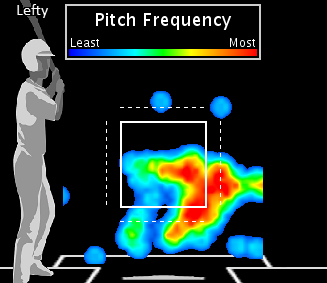Halladay says he is healthy after rough outing and more
 Jason Shaker |
Jason Shaker |  Tuesday, March 12, 2013 at 7:35PM
Tuesday, March 12, 2013 at 7:35PM
"Roy Halladay insisted Tuesday that he is fine.
But is he really?
He struggled terribly in 2 2/3 innings at Bright House Field against a lineup featuring mostly Detroit Tigers reserves. He allowed six hits, seven runs, four walks, one wild pitch, two home runs and one hit batsman. He lacked tempo and command throughout the start. He also lacked velocity. One scout said his fastball hit just 86-88 mph on the radar gun. Other reports had gun readings clocking his fastball a mile or two less than that.
Halladay's velocity has dropped since his first two Grapefruit League starts, when he sat in the 89-91 mph range. It dropped into the 86-88 mph range in his third start before sitting in about the same area Tuesday.
Halladay appears to be going in the wrong direction with Opening Day just 20 days away.
"The good part is, there's no soreness," Halladay said. "Nothing hurts."
He blamed his troubling performance on lethargy. He said a completely revamped, more intense workout program, plus throwing two bullpen sessions in between starts, contributed to his lackluster performance.
"I think I've always been a lot harder on myself than any of you guys have ever been. I can promise you that," he said. "You also are aware of what's going on, and it's hard to explain sometimes how you're feeling, what you're working on, what you're going through, what you're trying to do. When you know in your head what's going on, it's a lot different."
Source: MLB.com
Lawrie expects to be ready for season opener
"Brett Lawrie insists there’s no reason to worry.
Blue Jays fans, of course, will worry anyway.
The injured third baseman returned to the Jays spring training complex on Tuesday morning to see team doctors and training staff after participating in a non-active role with Team Canada at the World Baseball Classic until the Canadians were eliminated Sunday night."
Source: Thestar.com
Samardzija turns corner as opening day approaches
"Three weeks before he takes the mound on Opening Day in Pittsburgh, Jeff Samardzija moved closer to being ready for the Cubs' first game that counts.
While Samardzija's line -- 4 2/3 innings, 4 earned runs, 4 hits, 2 walks and 2 home runs allowed -- wasn't what he'll look for in 21 days, he was nevertheless encouraged by how he felt after ramping up the intensity for the first time this spring.
"I really thought today was a big turn for me, just how I felt, my pitch execution -- if I missed, I didn't miss by much," Samardzija said. "The adjustments I need to make are pretty simple, I feel like."
Source: CSNchicago.com
Patient appraoch with Ortiz is the right move
"I don't think it requires high levels of cynicism in the bloodstream to have heard the Red Sox' recent explanation for sore-heeled David Ortiz's scheduled five-to-seven-day hiatus and immediately mutter: ''Right. More like five to seven weeks."
I suppose any time the Red Sox' medical team concludes a diagnosis without alienating a player is a victory nowadays. But let's just say Monday's acknowledgement that Ortiz, who was limited to just 90 games last season after suffering a slight tear in his right Achilles' tendon, will probably begin the season on the disabled list hardly comes as a surprise."
Source: Boston.com
Jeter to play shortstop Wednesday
"Derek Jeter says he will play at shortstop Wednesday night against the Philadelphia Phillies.
It's the first time in the field for Jeter since ankle surgery last fall. Jeter says Tuesday after working out in Tampa that he'll "be out there" against the Phillies after two games as the designated hitter.
The game Wednesday also marks the spring training debut for Yankees pitcher Andy Pettitte.
Jeter went 0 for 2 Monday in his second game at DH since breaking his left ankle in October. He had a single in two at-bats Saturday."
Source: NYPost.com
Joe Nathan still building arm strength
"Texas Rangers closer Joe Nathan gave up back-to-back triples Monday, but the bigger development was the progress of his slider. After the two triples, which accounted for San Francisco’s second run in a 2-1 victory, he found the Giants committing to and chasing his slider. That led to three consecutive strikeouts.
Nathan said his arm strength is still lacking, but that it has come later during spring training in recent years. He compiled a 10.29 ERA in seven spring games last year and a 9.72 in 2011, his first year back from Tommy John surgery."
Source: Dallasnews.com
Nick Markakis out roughly two weeks
"The cause of Nick Markakis’ neck soreness is more severe than originally thought, but the Orioles hope that some rest will allow the team’s starting right fielder to return to spring training games in the next week or two.
A MRI on Monday revealed a small disk herniation — or slight tear — in the C4-C5 section (neck area) of Markakis’ spine, manager Buck Showalter said."
Source: Baltimoresun.com
 Email Article | |
Email Article | |  Permalink |
Permalink |  Print Article
Print Article
 Blue Jays,
Blue Jays,  Cubs,
Cubs,  David Ortiz,
David Ortiz,  Jeff Samardzija,
Jeff Samardzija,  Jeter,
Jeter,  Joe Nathan,
Joe Nathan,  Markakis,
Markakis,  Orioles,
Orioles,  Red Sox,
Red Sox,  Roy Halladay,
Roy Halladay,  Yankees,
Yankees,  rangers
rangers


